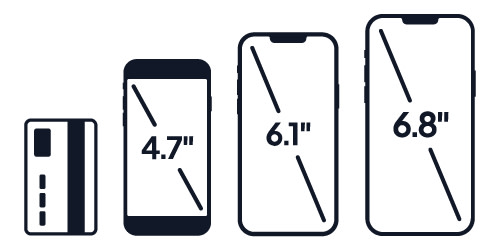What goes into finding the perfect phone

Questions
iPhone or Android
iPhones and Androids are the two main types of smartphones. iPhones are made by Apple. Androids are made by a variety of manufacturers including Samsung and Google. iPhones and Androids use different operating systems and most consumers stick with the same type of phone when upgrading to a new model.
Phone Size
Phone size is a very important consideration for many people. The size of the phone affects not only how easily a phone fits in your hand or how big the screen is, but also how much battery life the phone has. Since the screen takes up the entire front of modern phones, we use the diagonal screen size measurement to describe the size of the phone. The smallest phone in our database is the iPhone SE with a 4.7” screen, while several of the largest Android phones are 6.8”.

Budget
While many consumers choose to finance their phones through their carrier and pay a monthly fee instead of purchasing the phone upfront, you should define your budget here as the total amount you’re willing to pay over the life of the phone.
Camera Quality
Camera quality measures the camera’s performance taking photos and videos. It is a function of both the phone’s physical hardware and its image processing software. The best phone cameras feature optical zoom and several lenses to capture wide-angle, portrait and selfie photos.
Battery Life
Your phone’s battery life is a function of your use patterns as well as the physical size of the battery. As a general rule, larger phones have longer battery life.
Feature Preference
In some cases, there’s no phone that exactly fits all of your preferences. In order to make the best possible recommendation, we need to find out what feature is most important to you.
Special Features
Select any special features you require and we’ll make sure your final recommendations meet your needs.
Wireless Charging: Devices capable of being charged wirelessly on a charging pad.
SD Card: Phones with SD card slots for data storage.
Headphone Jack: Devices with a headphone jack for audio output.
Dual SIM: Phones with dual SIM card support for multiple phone numbers.
OLED Display: Phones featuring OLED display technology.
High Refresh Rate (90 Hz+): Devices with screen refresh rate above 90 Hz for smooth visuals.
High Performance (GB5.4 2.5K+): Devices that score above 2,500 on the GeekBench 5.4 rating system.
Specifications & Ratings
Screen Size
Screen size is a diagonal measurement of the screen from the upper left corner to the bottom right corner. The smallest phone in our database is the iPhone SE at 4.7,” while several of the largest phones are 6.8”.
Camera Score
We evaluate cameras on a ten point scale incorporating multiple metrics, including: overall picture quality, overall video quality, ease of use, image stabilization, and ability to handle moving subjects and dark environments.
Battery Life
Battery life is an estimate of how many hours a battery will last when actively using a phone for a variety of activities. Actual battery life will vary depending on how you actually use your phone.. Browsing the internet or making a phone call drains the battery moderately. Streaming, making video calls and playing games drains the battery fastest. Our estimate assumes that you split your time evenly between talking on the phone, browsing the internet, and watching videos.